Tokyo is a sprawling and diverse city with so many things to see and do. These are our top places to visit in Tokyo as a couple but most will have appeal to families and solo travellers too. Some sights are a must in particular seasons but most will give an appreciation of this fascinating city at any time of year.
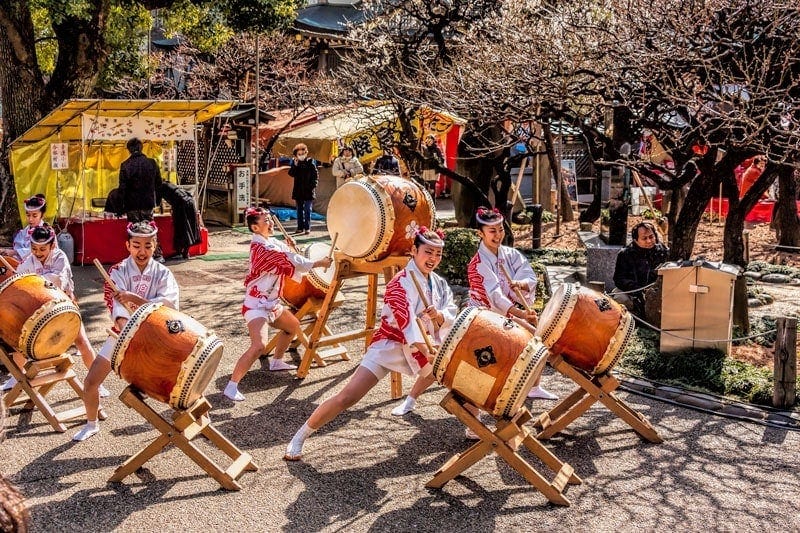
Tokyo is a city of contrasts and contradictions, at one moment steeped in tradition and reserved, the next a mass of flashing neon and cutting edge technology. There are massive parks, even a forest in the middle of a city that is one of the most densely populated in the world. In our experience, it’s a very clean city and feels safe even late in the evening although it’s always advised to stay aware of your surroundings and practice common sense anywhere in the world.
Tokyo has been the capital of Japan since 1868 and while its history isn’t as evident as it is in many other parts of Japan, there are still pockets where it has prevailed and the urban sprawl has been resisted. You’ll notice many small shrines tucked in between towering city buildings. Asakusa is perhaps one of the best-known parts of Tokyo for its historic and cultural identity but the remnants of Edo Castle and the Imperial Palace in the central city are another top spot along with Meiji Shrine, Golden Gai, Nezu Shrine and areas like Yanasen and Yanaka Ginza.
The places you choose to visit in Tokyo, as with the rest of Japan, might be heavily influenced by the season. The cherry blossoms and autumn leaves immediately come to mind but winter brings several months of dramatic light-up events and in summer there are festivals and fireworks to look forward to.
Food is also heavily influenced by the season and you’ll find fabulous foodie options everywhere. You can get great cuisine from tiny family restaurants through to fine dining, at festivals, street food vendors and even convenience stores.
In a city where 230+ restaurants have been awarded Michelin stars there’s a lot of competition and just because you are on a budget doesn’t mean you’ll miss out on the fun either. With options like Michelin starred Tsuta serving up exquisite bowls of ramen for under Y1000 (A$15) eating well is within the reach of most visitors
Table of Contents
Harajuku and Shibuya
Meiji Shrine

Located directly behind Harajuku Station this massive Shinto Shrine complex was opened in 1920 dedicated to the late Emperor Meiji and his wife. Situated in a dramatic man-made forest this is an oasis of calm and tranquillity in one of the most vibrant and busy parts of the city.
We have a full guide to Meiji Shrine and another on etiquette for visiting a Shinto Shrine.
Cosplayers on Harajuku Overpass
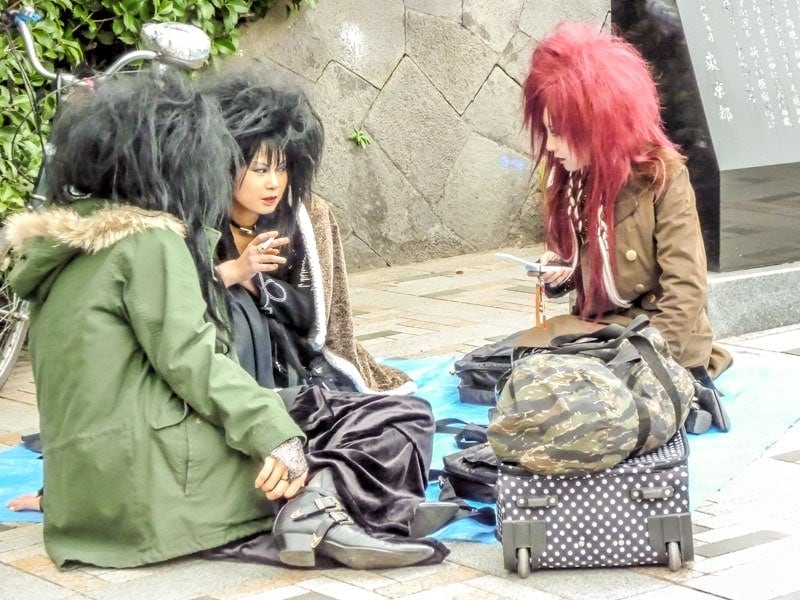
The otaku and cosplay culture is still going strong in Tokyo and you’ll often see young men and women dressed in their exquisite costumes, these outfits are often high quality and made with exceptional attention to detail. Cosplayers put both time and investment into their outfits, the Lolita fashion particularly is an expensive hobby with outfits reflecting the season, especially as they enjoy the cherry blossom.
One of the best places to experience cosplay is on the overpass between Meiji Shrine and Yoyogi Park, we’ve found Sunday afternoon the best time to be there.
Yoyogi Park
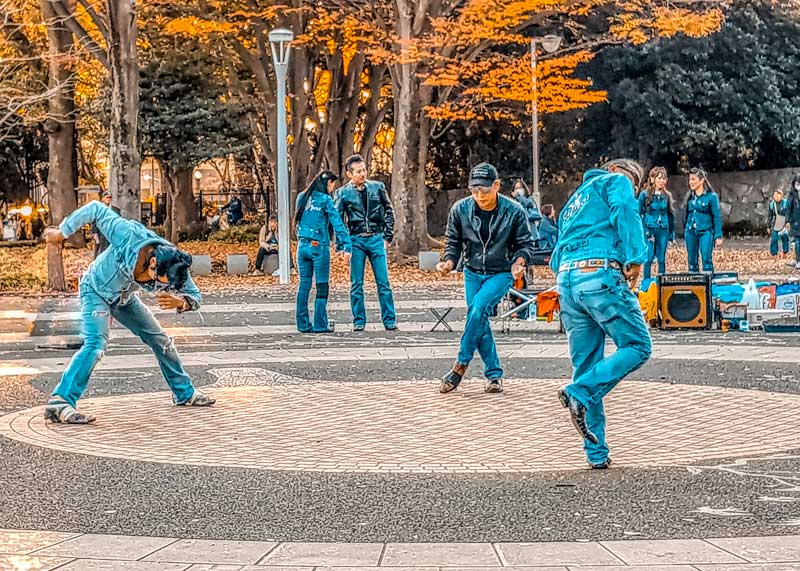
Slightly past the overpass and adjacent to Meiji Shrine, you’ll find Yoyogi Park. This is one of the city’s biggest parks and you’ll always find something going on here. From Rock and Rolling Elvis lookalikes to hanami parties in the spring, Lolita gatherings, skateboarding dogs and rabbits out walking in their Sunday best.
Locals love to gather in this local park and whether you are after some space for the kids to run and play or a quiet spot to people watch and relax for a while, Yoyogi Park has it.
Takeshita-Dori
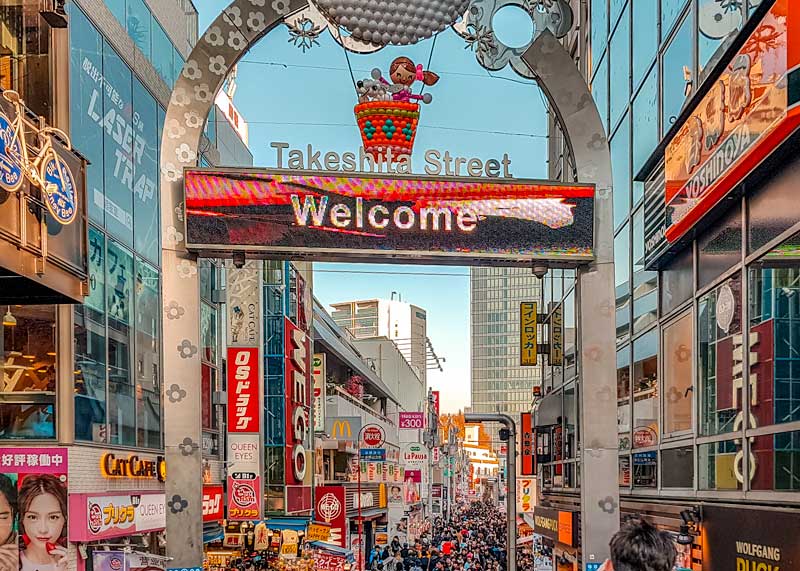
The best-known street in Harajuku is Takeshita-dori and you really do have to come here at least once. Be warned that you’ll find it packed on most days and times but on the weekends it’s even more so. It’s a destination for the young and hip, colourful sweet food is in abundance, skincare and makeup stores, fun trendy fashion and kawaii accessories. This is Harajuku.
Cat Street
Looking for somewhere less intense than Takeshita-Dori but still edgy and hip. You want to head towards Omotosando and take in Cat Street which runs from Omotosando into Shibuya. This street is trendy and features a diverse range of boutiques, vintage clothing stores and high-end shops.
Many of the cafes and restaurants here are western fusion but not the usual culprits, things like Good Town Doughnuts and Lukes Lobster are thriving. It’s a calmer pace with fewer crowds and is a good option to browse the shops as you head between Shibuya and Harajuku.
Just to manage expectations, don’t head here to see cats, cat cafes or cat-themed souvenirs. There are no cats.
Nezu Museum
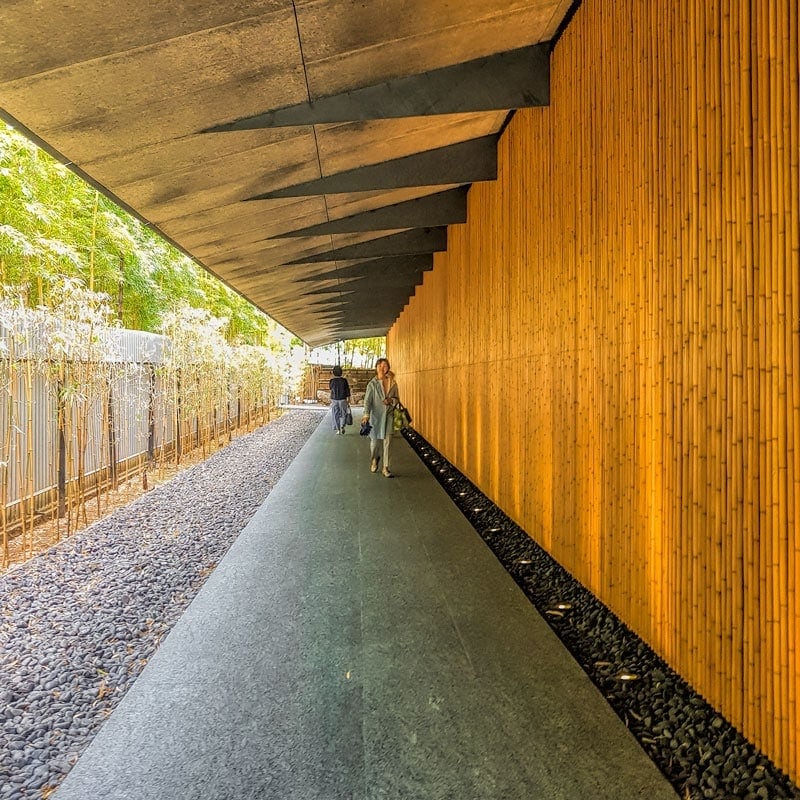
This small but fabulous private art museum is located in Aoyama. Entry is Y1300 and includes the curated special collection which changes regularly together with access to the beautiful strolling garden.
While we were there the collection on display included painted Japanese screens from the 17th and 18th centuries featuring the iris, a flower fully in bloom in the stunning garden and starting to bloom in gardens around Japan. There was also a display room featuring a scene from the book, the tales of Genji, which is set in Uji, Kyoto which we visited later in the trip.
One of my favourite things about the museum is the beautiful tea rooms with views out to the garden, they serve a limited range of food items together with their Nezu coffee blend, green tea and traditional sweets. To me, Nezu, especially the garden and tea shop are one of the city’s hidden gems.
Do check their website before visiting as they have regular closing days and also periods between exhibitions that they aren’t open.
Find Nezu Museum at 6 Chome-5-1 Minamiaoyama, Minato City, Tokyo 107-0062, Japan
Shibuya Crossing
While it is just a pedestrian crossing the Shibuya Scramble is quite a sight and quintessentially Tokyo. It’s the busiest crossing in Japan and possibly the world with up to 3000 people at busy times crossing at once in all directions. Experience it from within the scramble but also looking down on the hoards from above will give a fun perspective.
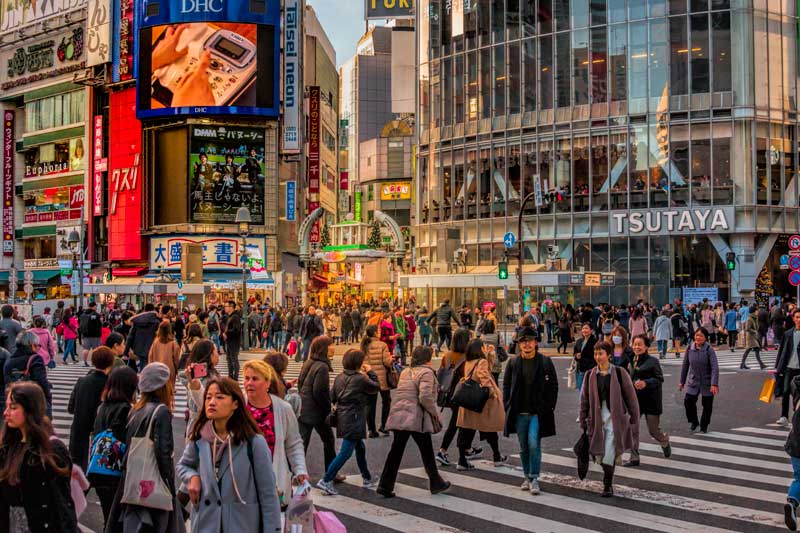
Starbucks is a popular viewing spot but you may need to lean through a gap for a view and photo as the seating at the bar tables are packed pretty much any time of day but there are other viewing spots in the surrounding buildings and shopping centres. The rooftop of the newish Mags Park has the elevation to give some of the best views and is open daily from 11 am until 11 pm but they do now charge an entry fee.
Sakurai Tea Cafe
Heading past Omotesando to Aoyama you can experience a modern but immersive tea experience in Tokyo. Shinya Sakurai is a master of tea, when you step into his store you’ll experience a collection curated personally from the best growers across Japan. In the front, you can purchase packaged teas and out the back, you can taste individual varieties or splurge on the tea tasting course. If you love tea, especially the diversity of Japanese tea, this might be the experience you are looking for.
Find Sakurai at 〒107-0062 Tokyo, 港区Minamiaoyama, 5 Chome−6−23 スパイラルビル5F
Get jiggy with Japanese souffle style pancakes
There are a number of cafes and chains across Japan specialising in these fluffy jiggly pancakes but A Happy Pancake in Omotesando is one of the best. You can choose from sweet or savoury and a whole range of toppings alongside some pretty good coffee or tea options.
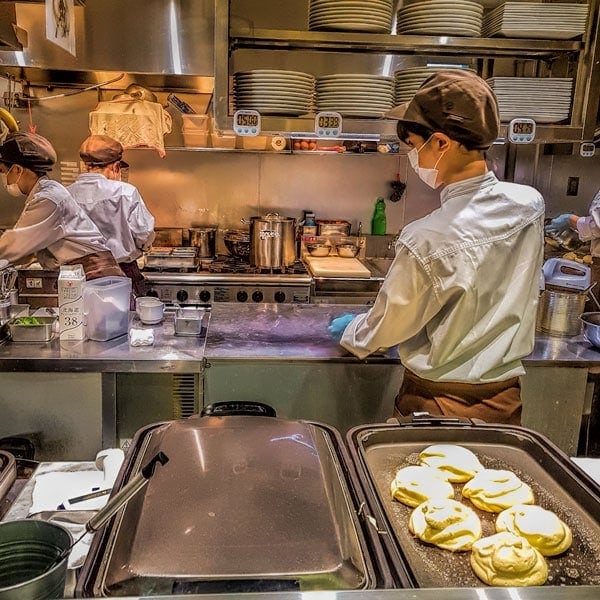
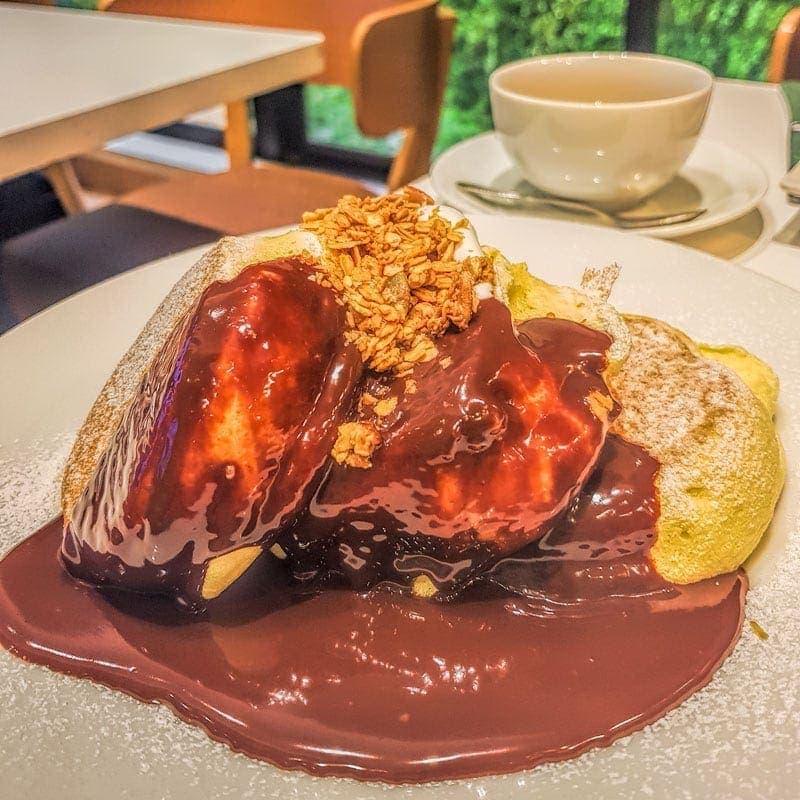
The place is easy to find from Google Maps if you pop in the name or address and although it is below ground the signage is good so you won’t miss it. If you go at opening time as we did make sure you pop your name onto the list just outside the door, in English is fine, you will be called in order as this place is super popular and fills fast.
Although I’m normally a savoury brunch person I picked a sweet option as that is where these pancakes really come into their own. They are light and airy, made with quality ingredients, that chocolate sauce is basically a ganache, rich and full of flavour and the granola adds just a touch of texture.
You’ll find A Happy Pancake at Japan, 〒150-0001 Tokyo, Shibuya City, Jingumae, 4 Chome−9−3 清原ビル B1F. For more information see their website and more reviews and photos on TripAdvisor.
Central Tokyo
Tokyo Imperial Palace
The centre of Tokyo is the Imperial Palace and the site of the original Edo Castle. Our visitors guide to the Tokyo Imperial Palace will give you an understanding of how the site is structured today and help you plan where you want to head and how to allocate your time.
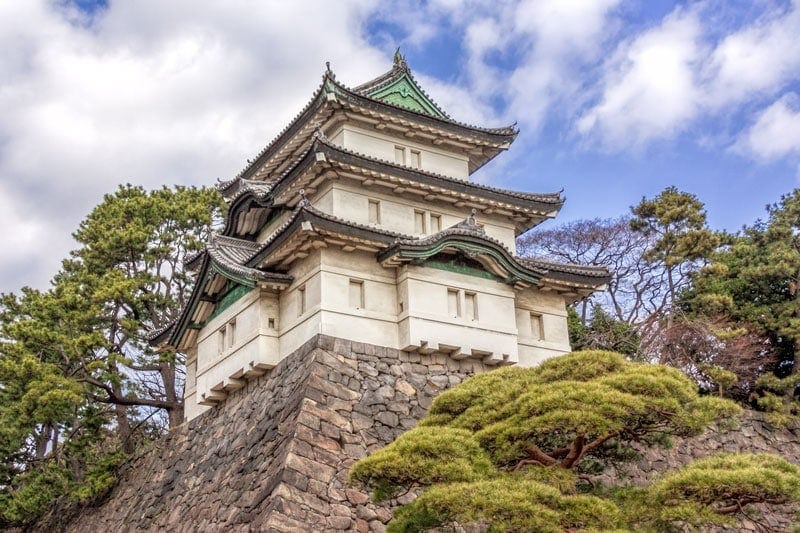
The daily tours give access to the section of the property that includes the Emperor’s actual residence and functional administration of the Imperial household. You don’t glimpse the private buildings even on the guided tour but you do get to see behind the scenes to a part that you otherwise wouldn’t.
There is still plenty you can see without joining the official tour if time is limited. We squeezed in a short visit on our 2019 trip to mark the end of the Heisei period. Emperor Akihito’s abdication on the 30th of April 2019 began the Reiwa era with Crown Prince Naruhito ascending to the throne.
Tokyo Station
Tokyo Station is a particularly convenient location for travellers in Tokyo giving access to both above-ground trains and the subway. It’s also a major stop for Shinkansen (bullet trains) and the JR airport express known as the NEX.
The station is also a destination in itself. The distinctive red brick building in Marunouchi, just across from the Imperial Palace was built in 1914 and has been given a major facelift recently. Inside it is packed with small restaurants and bars, shops and departments stores. There’s a luxury hotel in the station and many more at various budget points in the surrounding streets although being the heart of the business district too you’ll generally pay a little more, or get a little less for your yen a short walk from the station.
Imperial East Gardens

The East Garden of the Imperial Palace is a popular park right in the centre of Tokyo. With wide-open spaces, the ruins of Edo Castle and a Japanese style garden there is plenty to see. It’s also a popular place to watch the seasons bloom, from plum blossoms to cherry, azaleas to iris and hydrangeas.
A central Tokyo food tour
We joined this Tokyo foodie tour just up the road from Ginza station and over the course of 3-hours it took our tastebuds on a journey through Yurakucho, Ginza and Shinbashi. We’ve spent a good amount of time in Japan over the years and love the food but this evening gave us an insight into the culture behind the food that we hadn’t had before.
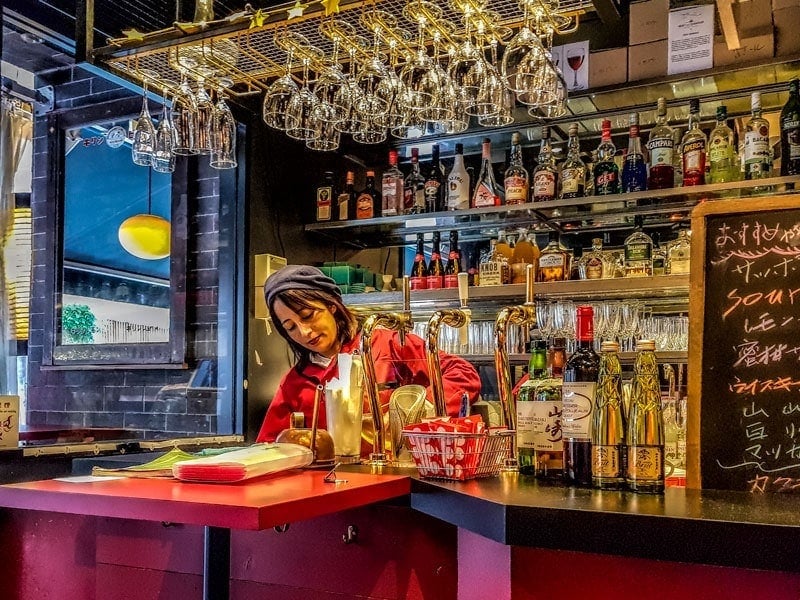
This particular tour moves through a diverse range of culinary styles as you walk from the food outlets running along under the train tracks to the glitzy and glamorous streets of Ginza and then to the ‘salaryman’ town out behind Steam Locomotive Square in Shinbashi.
Hie Shrine
This relatively small but significant shrine in Akasaka is one we discovered when we got ourselves a bit turned around on one of our first trips to Japan and being a short distance from Akasaka-Mitsuke station and close to some excellent cheap restaurants for a quick dinner after a full day out exploring we’ve passed by and detoured through a few times.

The shrine was established in 1478 and at one time stood within the grounds of Edo Castle. In 1659 the son of the Shogun Tokugawa Ieyasu had it moved to this location.
You might have seen pictures like this of rows of tori gates at Fushimi Inari shrine in Kyoto but if you aren’t getting out there you can also see it on a smaller scale here or at Nezu Shrine not far from Ueno.
Read more about the Shinto Hie Shrine.
KitKat shop and cafe
KitKat, the chocolate-coated wafer bar that originated in York in the UK has never been as popular as it is in Japan. You’ll find flavours and devotees here that you won’t anywhere else in the world, Japan has really made the humble KitKat its own.
If you are looking for a bargain novelty item to fill the suitcase to take home Donki (Don Quixote) stores are a great place to start with a decent variety but for the real novelty items make your way into a KitKat store. Over 300 flavours have now been released including regional and seasonal items.
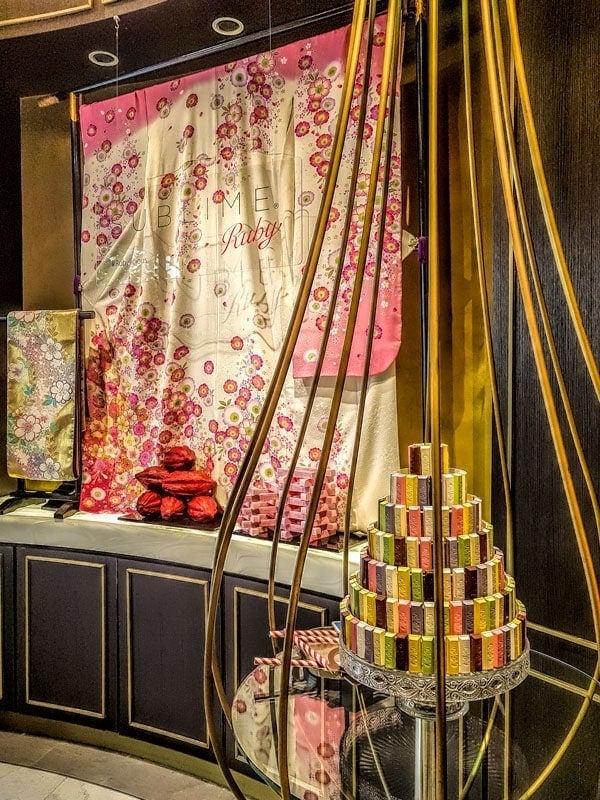

The reason for the love of all things KitKat is unclear but the brand has encouraged the association with the similar sounding phrase Kitto Katsu, which translates something like ‘you will surely win’ and it has become a popular small good luck charm or gift, especially for students with exams looming.
There are a few stores to choose from in Tokyo and around Japan but it is the central store in Ginza that is the flagship with a shop at street level and a kawaii pink cafe upstairs.
You’ll also find them in many markets and shopping streets you pass through in the cities, they will have bins of them in front with some interesting options. The sakura and sake combo was popular during our most recent visit, presumably because the blossom season had just ended and we picked up a bargain pack of the delicious ruby chocolate ones with dried berry topping in Kuromon Market that had been the current feature in the flagship store.
Location: 1st Floor (shop) and 2nd Floor (cafe), Oak Ginza Building 3-7-2 Ginza, Chuo-ku, Tokyo, 104-0061
Shinjuku
Shinjuku Gyoen
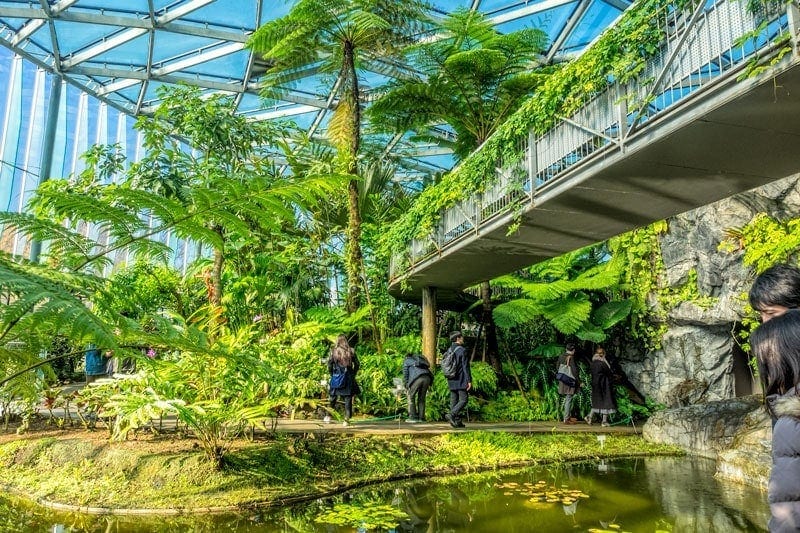
Shinjuku Gyoen or gardens are massive and are built to be enjoyed by everyone. Many parks and gardens in Japan don’t allow people onto the lawns to keep them looking their best but here is a public space that is open to playing and picnic on.
I loved this enormous tropical glasshouse most but there are flower gardens, cherry blossoms and avenues of autumn leaves in season, Japanese gardens and a couple of teahouses. If you are travelling with children there’s a good size playground and a splash pool too for toddlers in the warmer months. There are plenty of shade trees if you want to sit out for a while and public toilets and vending machines to grab a drink on site.
There is a token entry fee of Y200 and the park is usually closed on Mondays.
City views from the Municipal Building
There are a number of towers in Tokyo to get a birdseye view of the city and beyond. The Tokyo Municipal Building does have one major advantage though, it’s free! Plus the views are pretty good. The observation deck is at 202 metres on both the north and south tower.
Normally they are both open from 9.30 am with the south closing at 5.30 pm and the north at 11 pm. At times like the present when the south is temporarily closed for renovations, the north will extend its hours until 11 pm.
Tocho-Mae station is in the basement of the building and Shinjuku station is a 10-minute walk away.
Find all 200 exits from Shinjuku station
With 5 different train companies operating out of Shinjuku station it’s recognised as the busiest in the world with more than 3.5 million people passing through it every day. It also has around 200 exits, while I don’t genuinely suggest you try each and every one there is a chance you may not find the one you planned so just go with it and explore.
You can’t catch the Shinkansen (bullet trains) from here but Japan Rail, the Tokyo Metro, Odakyu, Keio and Toei Subway all have platforms.
Asakusa / Ueno
Ueno Park
The park entrance is very close to Ueno station and you’ll find this green space is busy with locals and tourists at pretty much any time of day. There are regular events and festivals held here, entertainment, date nights and picnics are popular reasons to visit. During the sakura season, the avenue under the trees is usually covered in blue mats as people enjoy drinks and picnics under the pink petals. A little later in the season focus changes to this gorgeous peony display.
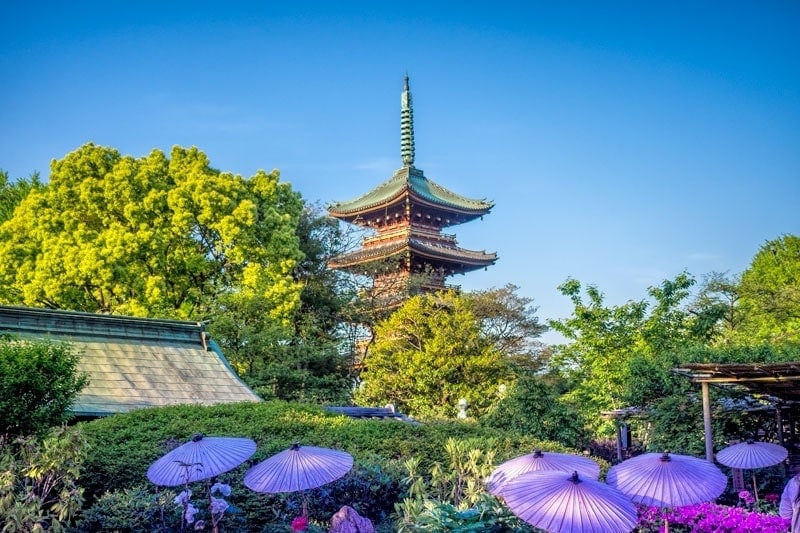
There is a lake here that is filled with waterlilies, you can hire swan boats for a romantic paddle or watch a variety of birds that make the area home. There’s a temple complex that once filled this area with around 60 buildings although only 3 remain today plus a shrine, impromptu entertainment and regular food markets down by the lake.
We think Ueno is a great part of Tokyo to visit and although it’s a less conventional choice it can even be a good base in the city. If you plan to visit you can find more ideas and tips in our Ueno guide.
National Museum
There are a variety of museums and galleries around the perimeter of Ueno park but the National Museum is well worth a visit. Many of the exhibits are free to enter and we really enjoyed the Buddhist art in the treasures of Horyuji exhibit from a temple in the ancient capital of Nara.
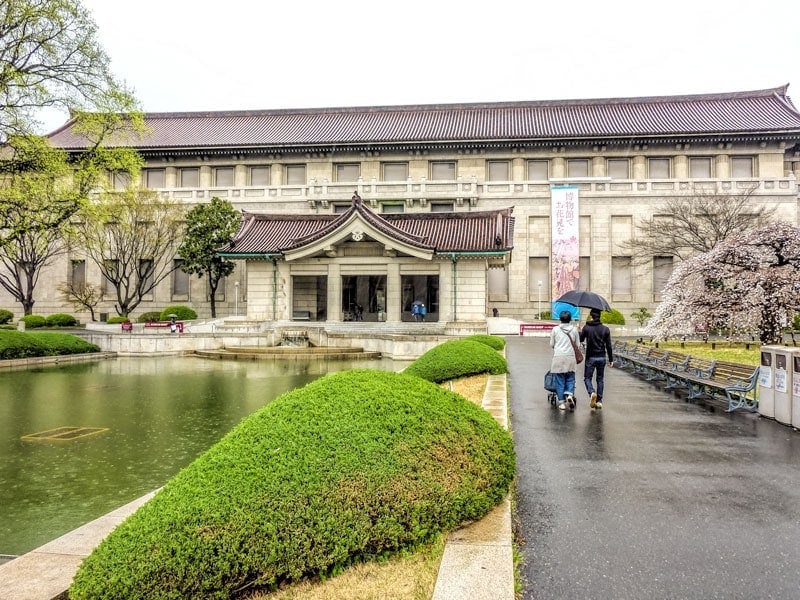
The various museums and galleries around the edge of Ueno Park are a great option if you get a wet day in the city.
Sensoji
For those wanting to experience Japanese history and culture in Tokyo heading to the low town or Asakusa is a good option. The street leading up to the castle is full of small stalls and shops selling street food and souvenirs, at either end is a huge gate with a lantern and opposite the entrance, the cultural centre offers a great overhead view from the viewing platform that is free to access.
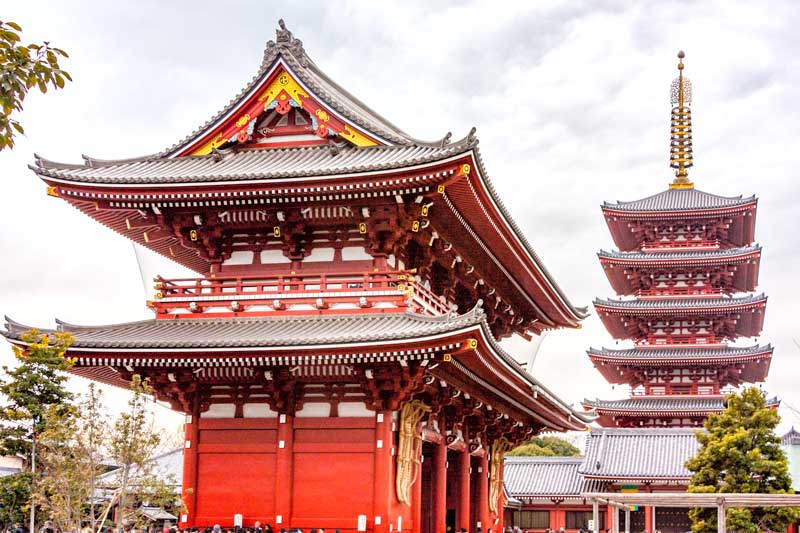
Sensoji is the temple and together with its garden, it is an impressive temple to visit comprising many buildings including a large hall and a pagoda. Asakusa shrine is located just to the right of the temple.
Ueno Secret Food Tour
The Ueno area is a great place to embrace the Tokyo food culture, you’ll find some great spots here at all price points and to tantalise the taste buds for most food preferences. We joined the Tokyo Secret Food tour on our most recent trip and discovered so much new and delicious, even in the Ameyoko market streets that I thought we had explored reasonably well over the years we tasted tea, learned about the ingredients of dashi, that essential stock that is a central component of so many dishes and found some fabulous street food.
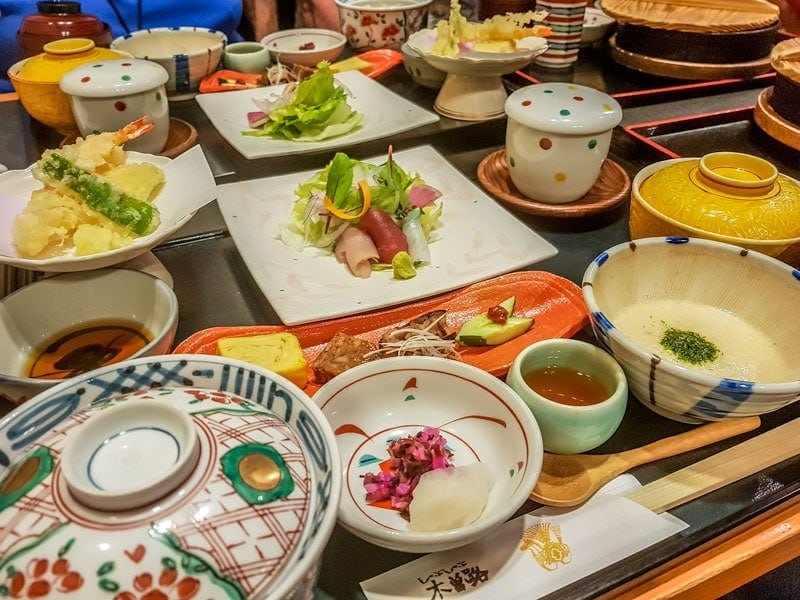
There’s a lot of food and drink to enjoy on this tour from street food basics like gyoza, menchi katsu and yakitori to a delicious seasonal lunch set and sushi freshly made in front of you.
You can read more about the foodie highlights of Ueno in this article.
Dress up in a kimono
The Japanese national dress is the kimono, an exceptionally elegant garment both in its design and that it binds you so firmly that for those not accustomed to it you will walk and sit with more poise naturally. The colours and designs change subtly with the season and I always enjoy seeing a woman on the street dressed in kimono, even better at the shrines you might spot a wedding in progress and those elaborate Shinto Wedding kimonos are works of art.
If you’d like to wear a kimono yourself there are a variety of places you can arrange to do that and many of them are able to accommodate English speaking visitors. You can either dress for photos only or walk around the city parks and gardens for a period of time to take some photos.
Plum blossom festival at Yushima Tenjin shrine
If you are in the city in late winter we really enjoyed a visit to Yushima Tenjin Shrine which is possibly THE best place to enjoy the plum blossom (ume) from mid to late February. There are over 300 trees in bloom and a variety of bonsai plum blossom trees to see too.

People have been coming to this spot to enjoy the blossoms since the Edo period and there is a fun festival held within the shrine grounds giving an additional reason to visit. There were food stalls and some really excellent girls performing on the taiko drums when we were there.
Getting here is a short walk from Ueno Park and the two are easily combined in the one visit. The shrine is dedicated to the 9th-century scholar Michizane Sugawara making it a popular spot for senior students to come during late winter as their exams approach. You’ll see many here in their school uniforms hanging ema tablets and buying charms in preparation.
Skytree

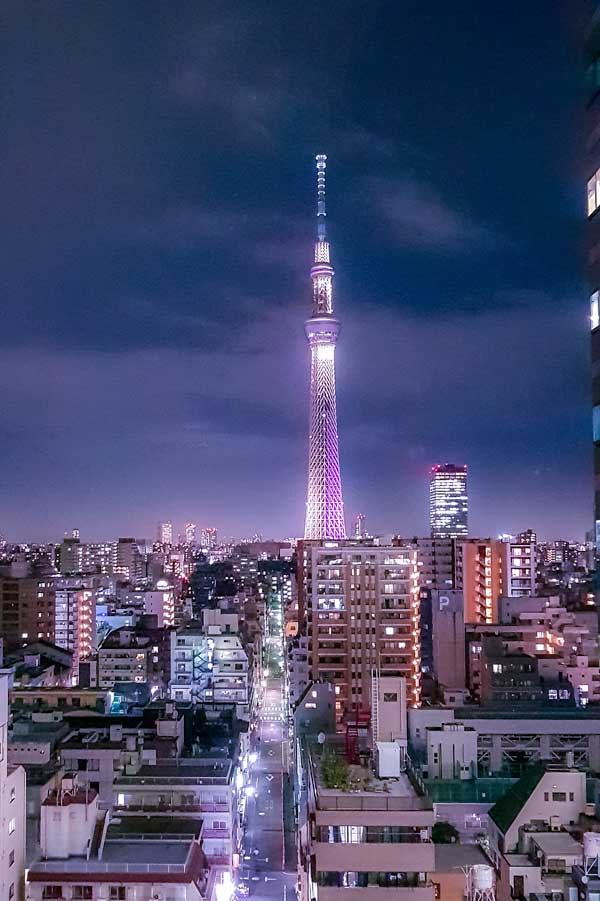
Finding a high point to look down on the city below can be a great way to get a perspective and orientate yourself in a city, especially one the size of Tokyo. I headed up the Tokyo Skytree last year and the view from there is extensive. Even on a less clear day, you’ll spot many of the city landmarks but if you get a day without much haze you’ll see all the way to Mt Fuji.
Eat Tokyo’s own Monjayaki
Osaka started the okonomiyaki trend and Hiroshima continued it adding noodles to their own griddle cooked pancake but did you know Tokyo has its own version known as monjayaki. It’s still mixed and cooked on the flat grill and generally tended in front of you but it’s a more liquid mix not set into a firm fritter as the others do so you eat it with a spatula, not chopsticks. Perhaps it looks a little less appealing but the taste is delicious.
You’ll find monjayaki in many places around Tokyo but I’d suggest heading out to one of the small restaurants in the side streets around Sensoji Temple in Asakusa to find a fun and authentic spot to try it.
World premier bonsai show
In February each year, Tokyo hosts the world’s premier bonsai show. Bonsai is a zen art form involving the tending of a tree by trimming its roots and branches and careful training to attain a miniature version of the full-sized plant. The show is called Kokufu-ten and attracts entrants and visitors from around the world.
The calibre of trees on display is incredible and in 2019 the show celebrated its 93rd year. It’s held at the Tokyo Metropolitan Art Museum and if you have an interest in bonsai and your visit coincides it is really an experience not to miss.
Other excellent bonsai are on display year-round at Showa Kinen Park in Tokyo and for a unique display of ‘bonbai’ which are a miniaturised plum or cherry blossom tree we’d highly recommend this show in Nagahama which is also held in winter, it’s a bit harder to get to but was excellent.
Akihabara
Walk through the neon wonderland
Known as Electric Town, Akihabara is the home of anime, neon and all things Otaku. The electronics shops here are legendary and this flashy and colourful part of the city is a fun place to spend some time.
You can shop for the manga, cosplay outfits and all things anime but you can also just spend some time soaking up the atmosphere of the neon-lit streets in the evening, experience a pachinko parlour or check out the latest in photography gear and electronic equipment.
Visit a maid or butler cafe
Maid cafes are a unique part of the Japanese otaku sub-culture. Dressed in French maid or similar anime costumes staff welcome clients to the cafe and act as a ‘servant’ for the duration of their time there. They take food and drink orders, play games and are generally attentive to the client during their time in the cafe.
While the maid cafe is an otaku equivalent of a hostess bar they do operate by strict codes and customers are not allowed to touch the maid or ask personal questions. While they were originally established to cater to the fetishes of male otaku more recently the clientele has widened to include women and frequently tourists.
The cafes originated in Akihabara and it’s still where you’ll find many of them. Maidreamin is one of the newer variations that offer a family-friendly alternative, the uniforms and anime feel are the same but the colour and cuteness are amped up, the maids perform a song and dance show and the food has that theme-cafe styling.
Shinto protection for the digital age
For something quintessentially Akihabara that I don’t imagine you’ll find anywhere else in the world take a short stroll from the station to the Kanda Shinto Shrine.
It has all the culture and history of a shrine originally established in 730 AD but the latest technology startups will come here to be blessed for success and you can pick up a talisman to protect your digital devices from evil. I’m hoping putting mine next to the phone will stop the incessant scam calls it currently attracts.
See Japan’s national sport in action
Sumo is a distinctly Japanese form of wrestling and its origin in the Shinto religion is still very evident in the traditions of the sport. There are 6 national competitions each year, held every second month and three of them are in Tokyo so this is your best chance to attend one. A tournament is the best way to get a taste of the sport and you can buy tickets to attend at a variety of price points.
If your visit doesn’t coincide with a tournament, and we rarely seem to time our visits to be in the right places at the right time, it can be more difficult to get a sumo experience as the sumo stables are quite a private place in general. Even stables that allow public visits are structured and generally require you to have a fluent Japanese speaking member in the group.
A morning sumo stable tour will get you a lot closer to the sumo wrestlers than you would at a tournament and you watch them training and practising their moves. The guide explains what they are doing, and the history and traditions of the sport which can help you enjoy an actual tournament even more.
The area of Ryogoku is the hub of all things sumo and is just 4 minutes by train from Akihabara. You’ll find the Kokugikan sumo stadium here and a small sumo museum that is free to visit. If you’re in the area why not try a bowl of chankonabe for lunch and dine like a Sumo.
Other city highlights
The latest Harry Potter tour experience
Warner Brothers launched their latest Studio Tour in Tokyo in 2023 and it is fantastic.
It is the world’s largest indoor Harry Potter experience and includes exclusive sets only available on the Tokyo studio tour. Platform 9 3/4, Diagon Alley, the Great Hall at Hogwarts and the Forbidden Forest are all features of the experience. There are also actual costumes from the movies and props that are so incredible to examine up close to spot all those incredible little details from the movies.
It’s located in Tokyo but a little outside the city centre. You can get there from Ikebukuro on the Seibo line or from most areas via the Toei Oedo subway line. The nearest station is Toshimaen, and it’s only a couple of minutes’ walk from there.
This is a great addition to our Tokyo list, replacing the Monster Cafe, which has sadly closed as an indoor experience in the city.
Book your tickets for the Making of Harry Potter Tokyo tour as early as possible. They must be booked in advance for your preferred time slot.
Want to know more? We have a full review with photos of the Harry Potter Studio Tour

Odaiba
Created entirely from re-claimed land by joining together a series of manmade fortifications in Tokyo Bay, this shopping and entertainment precinct is a fun place to visit in the city. Catch the driverless train across and try to get in the front car for a great view as it heads out through the spiral and over the bridge.
Things to do in Odaiba include checking out the teamLab Borderless show that I’ll cover below, the giant Gundam statue, the takoyaki museum (themed food hall), and a scale replica of the statue of liberty and the giant Ferris wheel. You can also walk out to one of the old fortifications now joined to Odaiba by a causeway, stroll the waterfront promenade or even take some time out to relax on the man-made beach, although there is no swimming here.
If you want to shop there are many options here but for a fun look around make sure to stop in at Venus Fort to experience this dog-friendly shopping precinct. There are dog-friendly cafes, play centres and dedicated stores stocking the latest cutest trends for your little buddy. Even the people bathrooms that are immaculate as Japanese public restrooms tend to be, have little stands next to every sink to sit down your doggy carry-bag while you wash and reapply your lippy, you wouldn’t want to put your designer doggy backpack on the floor after all.
teamLab Borderless Digital Art show
The teamLab Borderless digital art show has opened in its fabulous new location in Azabudai Hills near Roppongi and the experience was every bit as incredible as the original. We enjoy art in many forms, but street art and alternative art displays are our favourites, and these interactive projection art displays with a 3-dimensional element tick all the boxes.
You need to book online as soon as you can to get your pick of dates and times, but it is worth it. The first sessions in the morning are far less busy than those in the middle of the day. If you are interested, I’ll link our full teamLab borderless overview and review based on the new location here, or you can check current Borderless ticket prices and availability.
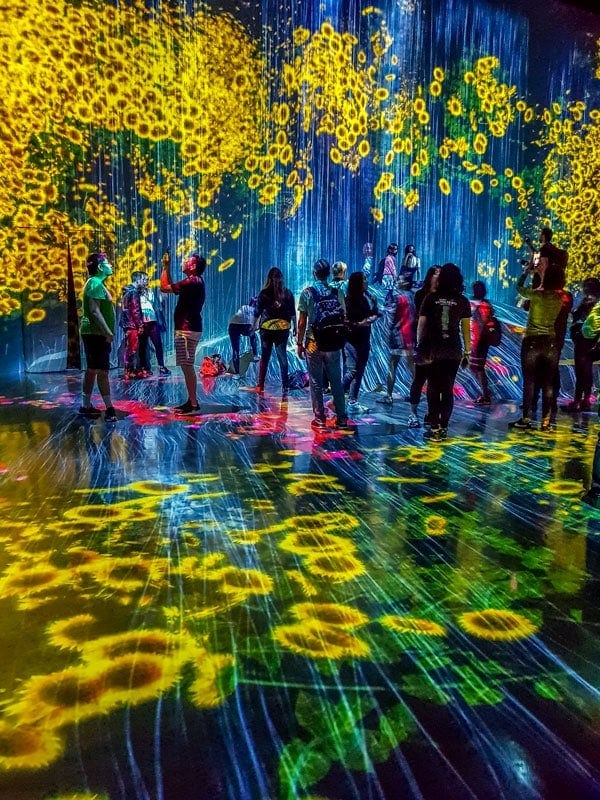
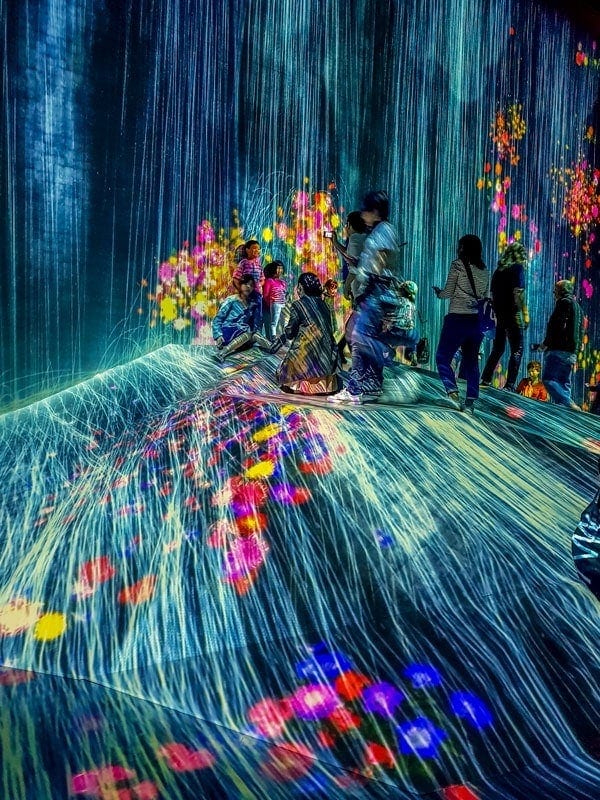
Make sure you do allow enough time for your visit, more than you might at a typical gallery. We spent around 4 hours at Borderless and I could have happily gone around all over again if we hadn’t had a foodie tour booked back in Ginza. I’d heard people say that teamLab shows are just for the Instagrammers but that wasn’t our experience at all.
You can spend ages in here just going through the different spaces and we have just heard that along with the extended season for Planets, they will also be adding more artwork spaces to keep it new and fresh. The first will be in autumn 2023 called Ephemeral Solidified Light and it will let you reach out and touch the crystals of light suspended in the air causing them to morph and change.
Rumour is that in addition to teamLab Planets, an all-new Borderless Artspace is being created at a secret local in the city due to open in early 2024. I have my hopes high that it will include a reimagination of the Borderless teahouse where flowers bloomed in your tea cups and followed plates and cups as they moved around on the tables.
Tsukiji outer market
Tsukiji Markets have been a popular spot with tourists for years, many turned up pre-dawn for the tuna auctions and they became so popular that they began to interfere with the commercial purpose of the world’s busiest fish market.
A decision was made a few years ago to move the wholesale function to a new location which has now happened but the main part of the market of interest to visitors and locals alike was always the outer market where you can try and buy many of the delicious fresh produce that is traded nearby.
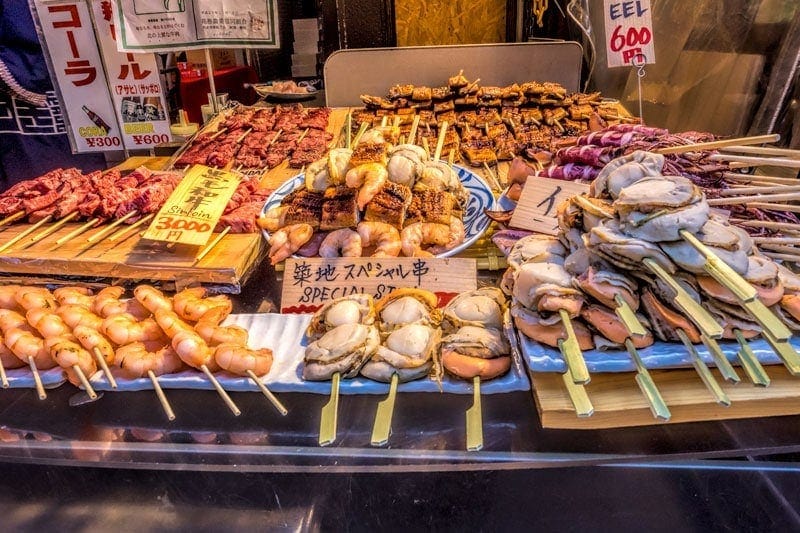
There are restaurants here too, knife shops and other kitchen supplies and the food isn’t only fish, there are many other sweet treats, vegetables and pickles available.
There was a suggestion that the outer markets would fizzle out but there is no sign of that happening, they were busier than ever on our recent visit and when options for some vendors to stay on in a new building were offered it was oversubscribed by 400%.
While I prefer Osaka’s Kuromon Market and Kyoto’s Nishiki Market overall, a trip down to Tsukiji is always a good way to spend a couple of hours, eat some delicious food and have a unique experience in the city.
Toyosu fish market
While the fish markets have now split into the wholesale and public sections it is still possible to watch the tuna auctions and see the workings of that section of the market. The new venue at Toyosu is a modern alternative and has a viewing floor where you can see the commercial activity below through a viewing window.
You won’t get down on the floor but if you are in the trade or have a particular interest it is still possible to add this experience to your itinerary. To be honest, it has been so busy for many years that you probably actually see more now from upstairs, it’s safer for everyone and they can focus on the business at hand.
Eat super fresh seafood for breakfast
The outer markets in Tsujiji are surrounded by wonderful sushi places. Heading down here for breakfast, brunch or lunch of incredibly fresh and deliciously prepared sushi remains one of my favourite things to do in Tokyo.
The sashimi donburi bowls are an excellent choice too if, like me, you struggle to choose and want to try a little of everything that is in season.
Hanami with the locals
Hanami is a picnic party under the cherry blossom, so naturally, it only takes place over a couple of weeks in the city each year but it is eagerly anticipated and something I’d highly recommend getting in on if you are in the city at the right time.

It takes place at many parks around the city including smaller local ones but Ueno, Yogogi and Shinjuku Gyoen are a few of the favourites and they do put on a spectacular display.
There are plenty of shops and often festival food carts near each of them to select some delicious food and drinks to enjoy with your friends. You can pick up a small version of the ubiquitous blue tarpaulins somewhere like Daiso for a couple of dollars so you’ll really look the part.
Tokyo River Cruise
The Sumida River runs through Tokyo from the north and out to Tokyo Bay. A cruise offers another way to get a feel for the city layout by meandering along the river. The boats run from Asakusa to Odaiba all year round but are particularly popular during the cherry blossom when the banks are fully in bloom.
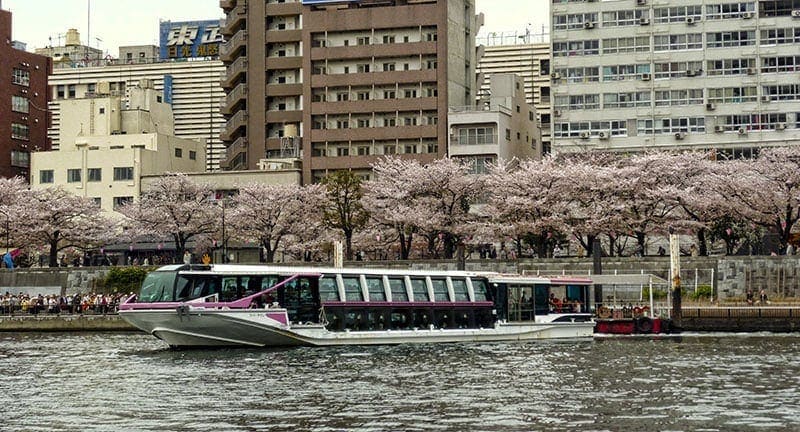
It is always more popular getting on at the Asakusa end so we did the river cruise in reverse coming up the river and spending the afternoon and having dinner in Asakusa, this worked really well, the boat wasn’t at all busy, we didn’t have to queue to board and when we saw the length of this line as we were about to get off we were very pleased we did things in that order.
Check the prices and booking details for the Sumida River Cruise
Visit a Pokemon store
I’m in love with all things Pokemon and yes I played the game on my phone long after the initial hype had passed. Even if you aren’t quite so committed these cute little monsters are part of the Japanese kawaii culture and the Pokemon stores are a fun place for a look around.
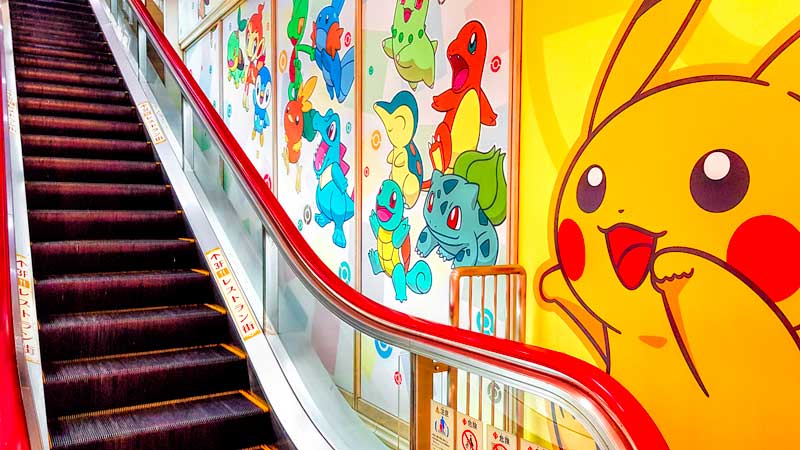
There are a number of them around Tokyo including Ikebukuro, Nihombashi and Skytree and even a Pokemon Cafe if you, or your kids, are major Pikachu fans.
Shiodome winter light display
During the winter season when many of the parks and gardens around the city are bare the nights light up with illuminations. You’ll find these all across the city, some only for a few weeks around Christmas but most start in late November and run through to mid-February.
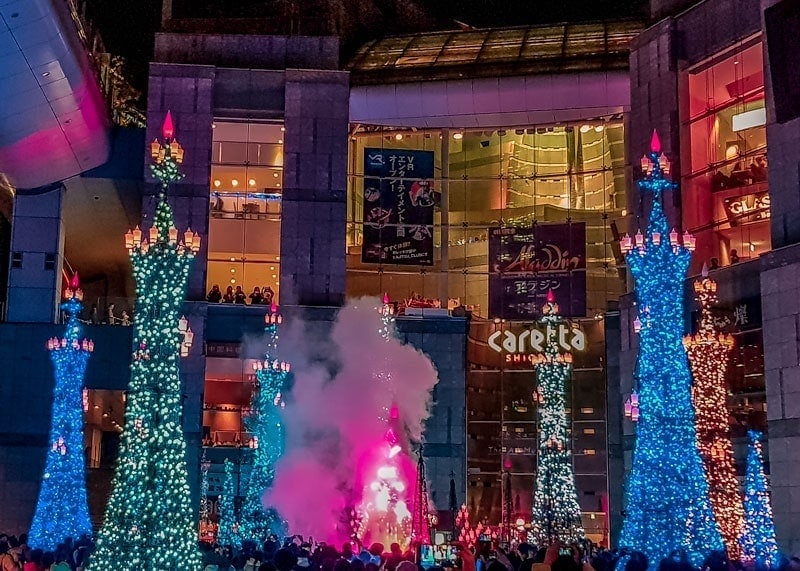
You’ll find quite a list here but our favourite is the one at Shiodome and this has the advantage of being just across from one of our top places to stay in the city, the Park Hotel Tokyo making it a convenient to duck across in the evening before or after dinner. Even if you aren’t staying close by I’d recommend coming into Shimbashi or Ginza one night for dinner and seeing this.
Tokyo suburbs and surrounds
Todoroki gorge
This is a relaxing spot for a couple of hours or half a day. The walking path isn’t very long but serene and pretty. Wander along through the only gorge in Tokyo along the canal, stop to explore shrines, temples and a small but beautiful Japanese garden.
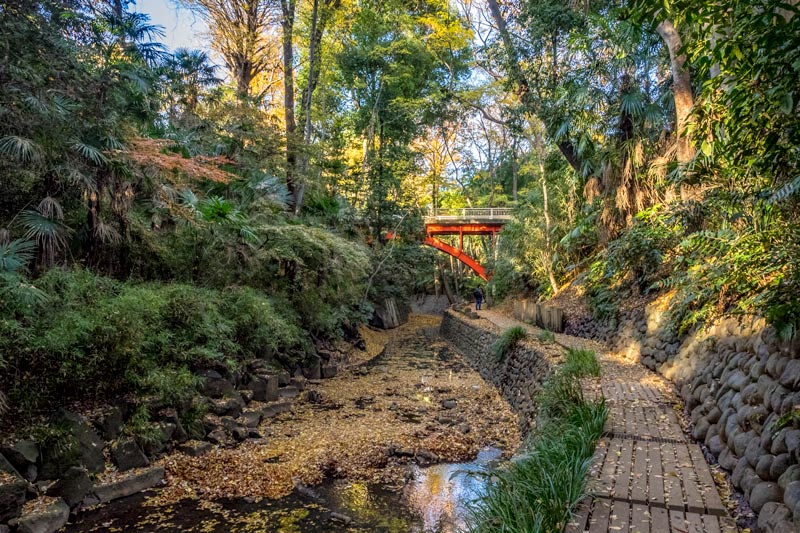
If you wander up off the main trail a little you will even find the site of ancient burial mounds in the same style as those seen in Sakai, Osaka or along the Kibi Plains cycling trail. Early on the walking path, you can also see ancient burial caves set into the hillside.
There are tea rooms at the base of the temple within the gorge if you want to sit out for a traditional tea and sweet or up near the train station there are a variety of restaurants and cafes.
Read more: Exploring Todoroki Gorge in Tokyo
Mt Takao
Within the greater Tokyo area this is a good option if you want a day out in nature, away from the crowds of the city and to experience a different side of Japan. You can take a ropeway or chairlifts up and down the mountain to around the midway point and the remainder is easy walking on wide paths and/or stairs.
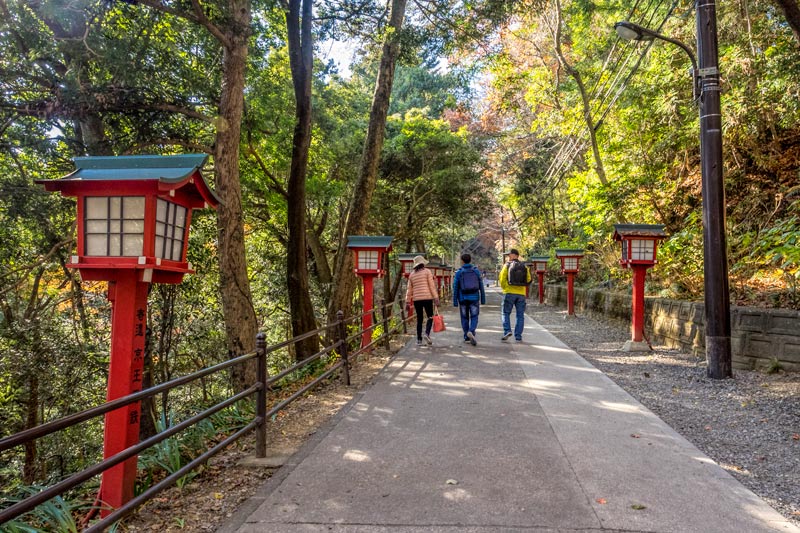
There are shrines and temples on the mountain, a restaurant and a monkey park. At the base, there is an onsen too if you want to end your day with a relaxing soak. It’s easy to get out here with the train system and the station is very close to the base of the mountain and ropeway starting point.
Mt Takao is most popular in autumn when many of the trees put on a spectacular display of autumn colour but this could be a good place to visit in any season. From the top, you will have views back out to Tokyo city in the distance and to Mt Fuji.
Read More: Planning your day exploring Mt Takao
Ghibli Museum
The Ghibli museum will transport you into the world of anime, especially if you grew up with the Studio Ghibli characters such as Totoro, Jiji and Ashitaka. It’s not surprising that this is one of the most popular attractions for families in Tokyo.
The museum isn’t large but the displays are well curated. You will note that the exhibit labels and the films are entirely in Japanese but that won’t matter to fans of Ghibli, it’s an experience that transcends language barriers and Totoro lovers will be in their element.
You can eat on-site in their cafe or use the dining facilities here to enjoy food and drink brought in with you. There is also a good park close by if you have children with you who might enjoy a bit more space to run around.
The museum does book to capacity regularly so it is recommended that to avoid disappointment when planning your visit to Ghibli you book well in advance to get tickets for the day you want. Visitor numbers are limited for each day and there are no same-day tickets available at the entrance so you do need to plan ahead. Sales are for a specific date and ticket sales open up 3 months in advance so we highly recommend booking online well before you leave home to avoid disappointment.
You can book through their own site although this seems to give a few issues for many foreign visitors, at a convenience store once in Japan if you aren’t too concerned about your particular dates and time or through a booking site.
You can also book online through one of our usual booking sites, we like that we can organise it in advance this way if we have only a few days still free in the city but there is a small premium included in the cost for the convenience.
Tokyo Disneyland
True to the label it probably is the happiest place on earth, especially if you are sharing it with young children who will love the familiar characters, shows and rides.
You can easily get to the Disney Resort from Tokyo city by train but it will generally require a few transfers. There are dedicated bus transfers from most areas of the city which cost slightly more than the train but do make things a little easier when travelling with the family. We’ve also stayed at some hotels such as the Tobu Levant that include free Disney transfers.
Check ticket prices for Tokyo Disney.
Tokyo DisneySea
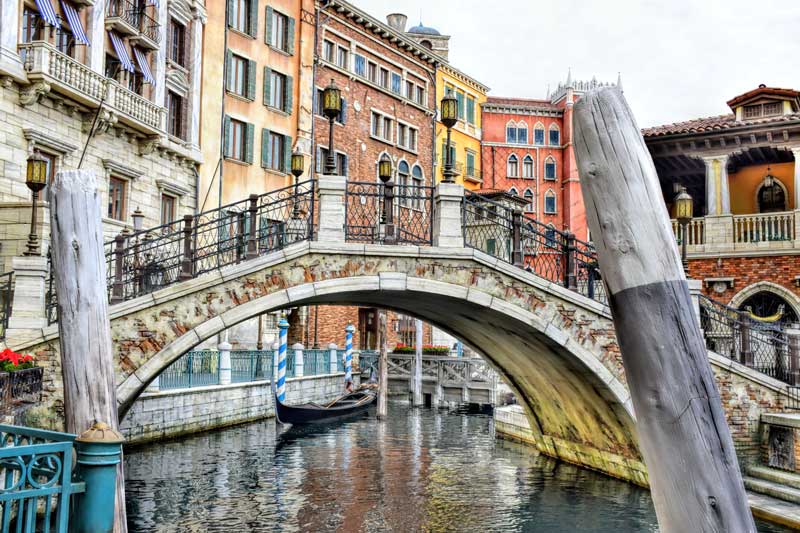
DisneySea is part of the Tokyo Disney Resort. Adults and older children might enjoy this unique Disney experience even more than the familiar Disney Land. The nautical theme continues throughout the 176-acre park which is divided into 7 ports that include unique rides, characters, shows and even have themed food items available in each.
Review the ticket options and prices for DisneySea
Getting to and around in Tokyo
Daily flights are available into Tokyo from the major Australian cities and we particularly like choosing multi-city options which let us save on travel time and cost by flying into one city and out of another at end of the trip. We find it a great way to maximise our time seeing the sights rather than rushing back across the country.
Narita Airport to Tokyo City
There are 3 main options that visitors regularly use for this trip. Taking a taxi isn’t a popular choice as Narita is actually located in a prefecture adjacent to Tokyo and is quite a distance away, they are useful at times in Japan but are expensive.
The Airport Limousine Bus is a coach service that runs frequently between the airport and various districts and hotels in Tokyo. If your hotel is a collection point this can be a great option after a long flight. It’s price competitive, takes a similar length of time and will often drop you directly at the door of your hotel. Check the Airport Limousine’s current pricing and routes.
The Narita Express (NEX) is a train service offered by Japan Rail. It’s an airport-specific service so it’s a bit easier to load and store suitcases than it would normally be on a local train and runs right into Tokyo station in the central city with other stops along the way.
The Skyliner is an alternative to the run by the Keisei Railway Company. This is similar to the NEX but useful if you are staying in or near Nippori or Ueno.
All the tips you need getting from Narita Airport to Tokyo
Useful tips for your visit
If you have a few extra days consider these great day trips out of Tokyo and if you have time to extend your visit further our guide to travel in Japan has a tonne of suggestions all the way from Hokkaido through to Okinawa.
While in Tokyo these bonus travel tip articles will help you get the most out of your stay
- Getting around quickly and with minimal stress will significantly add to your enjoyment of the city, in this article we cover a few tips that will help you master the Tokyo subway like a local
- We often buy the Japan Rail Pass for our trips but it’s not always needed depending on your travel style and itinerary. We’ll help you work out if the JR Pass is cost effective for your trip?
- Savouring the flavours is a big part of a trip down so we also share our favourite Japanese food to hunt down while in Tokyo
- We’ve visited Japan in all seasons and don’t believe there is a bad time of year to go but heat and humidity can provide some challenges when travelling. This article wraps up our tips for surviving summer in Tokyo.
If you found this article useful please consider saving it to Pinterest. It makes it easy for you to find it again, it helps us, and it helps other travellers to find the information they are looking for.
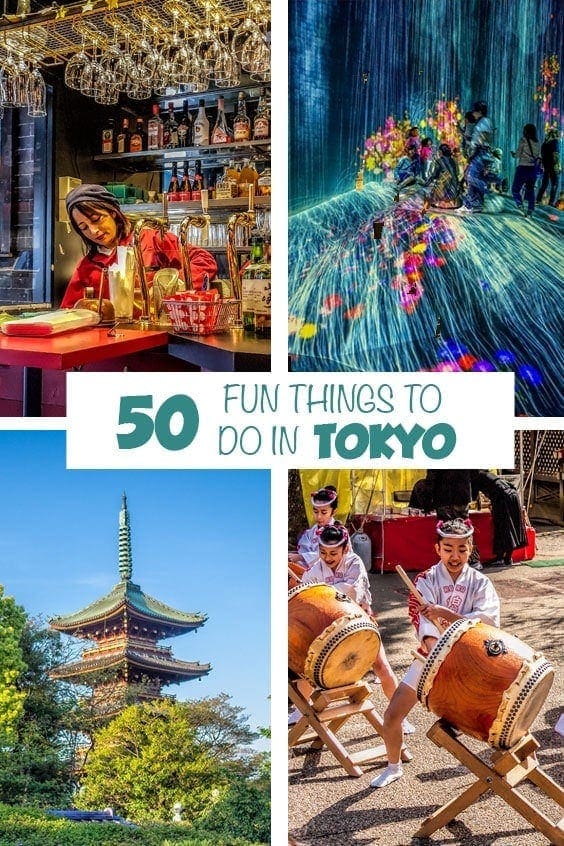
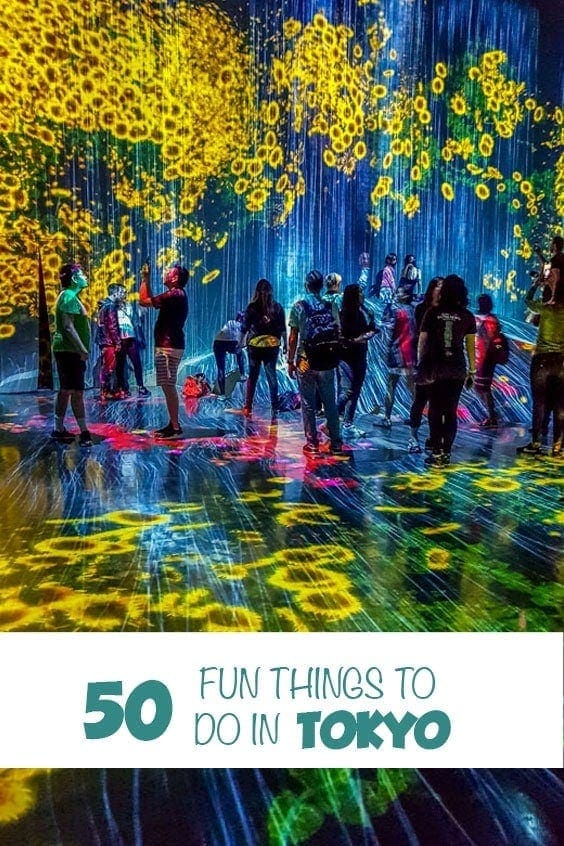
Hanae Suk Bragg
Monday 6th of February 2023
Thank you! I love that you divided up activities by neighborhood! Very helpful!